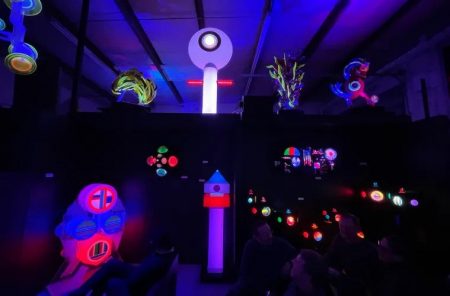
west wall of the Lumonics performance space (photo of Jennifer Hughes/303 Magazine)
Therapeutic Potential of Lumonics
Through the years (over 5 decades now) people have commonly reported to Dorothy Tanner having profound spiritual and emotional experiences while contemplating the Lumonics art pieces. Some of these experiences have led to considerable symptom reduction in individuals with pre-established mood and anxiety disorders. This suggests a potential role for Lumonics in complementing evidenced-based treatments in the outpatient psychiatric setting as well as in mental health and overall well-being of the population.
It is possible that Lumonics is exerting its effect by creating an immersive experience that feels safe and soothing, but also stimulating and expansive. The contents presented by Lumonics art works seem to have a harmonizing effect over the limbic system allowing for better synchronization with the prefrontal cortex and likely resulting in the creation of novel neural pathways that can help overcome maladaptive defense mechanisms within the individual. This could have particular implications in the treatment of Major Depressive Disorder (MDD) and Post-Traumatic Stress Disorder (PTSD) which are major public health concerns reaching epidemic proportions.
The therapeutic potentials of Lumonics need to be expeditiously investigated within an evidence-based medicine model that will likely necessitate input from a variety of techniques and disciplines such as biometrics, neurophysiology, structural and functional neuroimaging. As a board certified psychiatrist with special interests in clinical research, neuropsychiatry, as well as Integrative, Complimentary and Alternative Medicine (ICAM), I am actively seeking and eager to secure the proper funding needed to initiate these studies.
JOMAR P. SUAREZ, MD
Dr. Suarez is an adult psychiatrist trained at the University of Colorado and a
diplomat of the American Board of Psychiatry and Neurology. He has performed
research and completed courses at prestigious institutions such as Johns Hopkins
and the Memory and Aging Center at the University of California, San Francisco.
Dr. Suarez has a strong interest in neuroimaging and neuropsychiatry. He also
carries a strong background in molecular and clinical research. The research he
performed at the Memory and Aging Center resulted in a first author publication in
“Neurology” as well as an acknowledgement in a different publication in “Brain” – 2
of the most prestigious peer-reviewed journals in the field of Neurology.
Throughout his career, Dr. Suarez has received numerous academic awards and
scored on the top percentiles of his competency exams. Additionally, Dr. Suarez has
been awarded multiple scholarship and research fellowship opportunities including
the National Science Foundation Model Institutes of Excellence Scholarship, the
Doris Duke Foundation Fellowship and the Howard Hughes Medical Institutions –
National Institutes of Health (HHMI-NIH) Research Scholars Program.
Over the years Dr. Suarez has gained experienced in a broad variety of systems of
practice raging from academic, governmental, private practice and community
mental health settings. As a result, Dr. Suarez has become highly sensitive to the
needs of diverse patient populations and is extremely passionate regarding issues
of social advocacy and community development.
